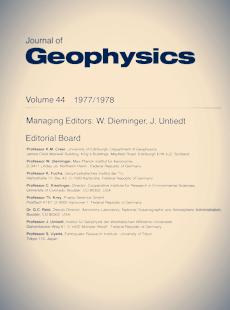Digital recording and analysis of broad-band seismic data at the Graefenberg (GRF) array
Article Sidebar

Vols. 1-18 (1924-1944), ISSN 0044-2801
Main Article Content
Abstract
An array of 19 broad-band seismometers with flat velocity response between 0.05 Hz and 5 Hz combined with a binary gain-ranging data acquisition system of 138 db dynamic range is being installed in Southern Germany. The array has a maximum extension of 80 km, it consists mainly of three triangular subarrays, the dimensions of which are chosen so as to reduce the microseisms by simple summation. The dynamic range is accomplished by digitizing the output at the seismometer sites and transmitting the digital information on telephone lines to a central control station. Single station data are available since 1975 and continuous recordings of the first subarray exist since 1976. They provide extended information of the fine structure of the seismic wave field in the medium frequency range between 0.5 Hz and 0.05 Hz and allow the quantitative investigation of frequency-dependent seismic phenomena over a wide range of amplitude and frequency. An elementary problem is the numerical analysis of broad-band seismograph systems especially seismometer-galvanometer systems and the determination of the true ground displacement or velocity. This simulation and restitution problem can be solved by digital recursive filters applying the z-form method. The simulation may include high sensitive short-period detection instruments.
 ARK: https://n2t.net/ark:/88439/y012005
ARK: https://n2t.net/ark:/88439/y012005
Permalink: https://geophysicsjournal.com/article/127
Article Details
References
Berckhemer, H. (1971) The concept of wide-band seismometry. Observ. Royal Belgique, Serie Geophys. No. 101:214-220
Green, P.E., Frosch, R.A., Romney, C.F. (1965) Principles of an experimental large aperture seismic array (LASA). Proc. IEEE 53:1821-1833
Harjes, H.-P., Henger, M. (1973) Array-Seismologie. Z. Geophys. 39:865-905
Henger, M. (1975) Wavenumber filtering of microseism with triangular arrays. NATO Advanced Study Institute Series, E: Applied Sciences 11:205-210
Kaiser, J.F. (1963) Design methods for sampled data filters. Proc. 1st Annu. Allerton Conf. Circuit System Theory 221-236
Kelly, E.J. (1967) Response of seismic arrays to wide-band signals. Linc. Lab. Techn. Note 1967-30
Peterson, J., Butler, H.M., Holcomb, L.G., Hutt, G.R. (1976) The Seismic Research Observatory Bull. Seism. Soc. Am. 66:2049-2068
Wielandt, E. (1975) Astatic vertical pendulum supported by a leaf spring. J. Geophys. 41:545-546











